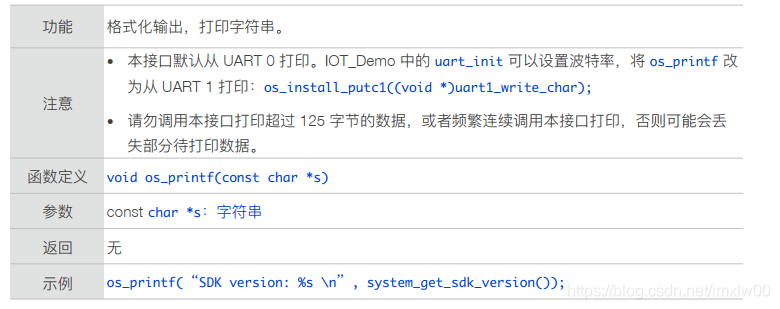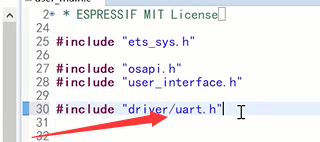1、Esp8266 串口打印SDK版本
本文共 603 字,大约阅读时间需要 2 分钟。
API
- os_printf

- system_get_sdk_version


实验
os_printf("\r\n---------------------------------\r\n"); os_printf("SDK version:%s\n",system_get_sdk_version()); // 串口打印SDK版本 os_printf("\r\nHello World\r\n"); os_printf("\r\n---------------------------------\r\n"); 
设置串口信息
如何设置串口的波特率、数据格式?需要调用串口驱动函数

- 项目添加文件



- 引用头文件

void ICACHE_FLASH_ATTR user_init(void){ uart_init(9600,9600); //初始化波特率,串口0和1 os_printf("\r\n---------------------------------\r\n"); os_printf("SDK version:%s\n",system_get_sdk_version()); // 串口打印SDK版本 uart0_sendStr("\r\nHello World\r\n"); os_printf("\r\n---------------------------------\r\n");} 

转载地址:http://whlqz.baihongyu.com/
你可能感兴趣的文章
Netty源码—8.编解码原理一
查看>>
Netty源码—8.编解码原理二
查看>>
Netty源码解读
查看>>
Netty的Socket编程详解-搭建服务端与客户端并进行数据传输
查看>>
Netty相关
查看>>
Netty简介
查看>>
Netty速成:基础+入门+中级+高级+源码架构+行业应用
查看>>
Netty遇到TCP发送缓冲区满了 写半包操作该如何处理
查看>>
Netty:ChannelPipeline和ChannelHandler为什么会鬼混在一起?
查看>>
Netty:原理架构解析
查看>>
Network Dissection:Quantifying Interpretability of Deep Visual Representations(深层视觉表征的量化解释)
查看>>
Network Sniffer and Connection Analyzer
查看>>
Network 灰鸽宝典【目录】
查看>>
NetworkX系列教程(11)-graph和其他数据格式转换
查看>>
Networkx读取军械调查-ITN综合传输网络?/读取GML文件
查看>>
network小学习
查看>>
Netwox网络工具使用详解
查看>>
Net与Flex入门
查看>>
net包之IPConn
查看>>
Net操作配置文件(Web.config|App.config)通用类
查看>>